Two years ago, I had a 6.6kW SolarEdge/Seraphim solar system installed on my house in Adelaide. A few months ago I decided to join the increasingly-less-exclusive club of home battery owners.
So I called back my original solar installer, and got them to add a spiffy SolarEdge Home Battery to my house. Three months on, it’s time to write about my installation experience, initial impressions, and bumps along the way.
Why The SolarEdge Home Battery?
Finn has a Tesla Powerwall and has extensively written about it, so he encouraged1 me to get a less common battery.
The SolarEdge Battery was only released in Australia 6 months ago (I believe mine was the second installed in Adelaide). For a while it was known as the ‘SolarEdge Energy Bank’, but SolarEdge Australia has since reverted to the imaginative ‘SolarEdge Home Battery’ moniker.
And SolarEdge was (and, I believe, still is) offering to upgrade older SolarEdge inverters (like my 5 kW HD Wave) to the new hybrid ‘Energy Hub’ inverter for free when you buy the SolarEdge Battery.
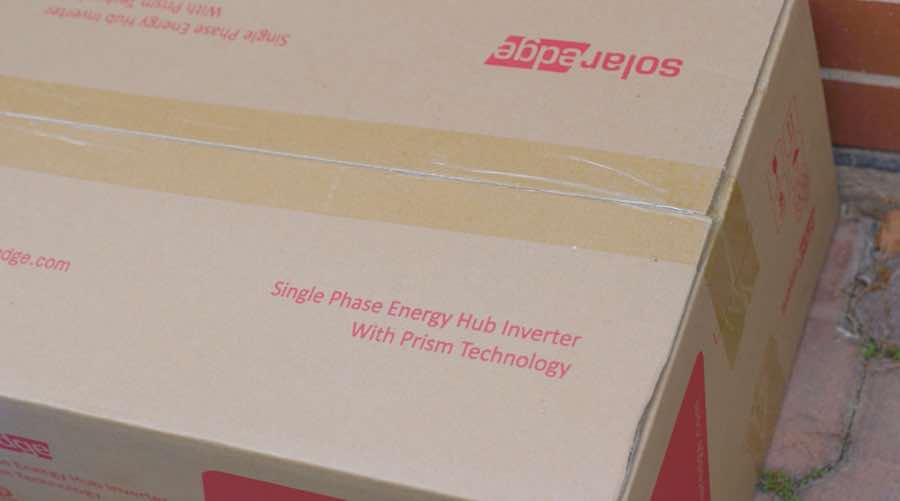
Free upgrade to SolarEdge Energy Hub Hybrid Inverter. Nice.
So, I got a great deal on a newly released battery + inverter upgrade. The total system price was $12,455. The SA Battery Rebate chipped in $1,455 making the final purchase price a very reasonable $11,000.
The battery can store 9.7 kWh of energy. Over the last two years, my average daily usage topped out at 13 kWh in winter – meaning 9.7 kWh of storage was the sweet spot of price and size for my situation.
I Got My Original Solar Installer To Come Back
Using the same installer who did your solar power system installation for a battery retrofit is not mandatory. But I decided to invite back my solar installer from two years ago – SEM Group.
This was because I wanted to keep all warranties under one roof. It makes things easier if I have any issues in the future. Plus – they did a fantastic job with my solar installation, so there was no reason not to invite them back!
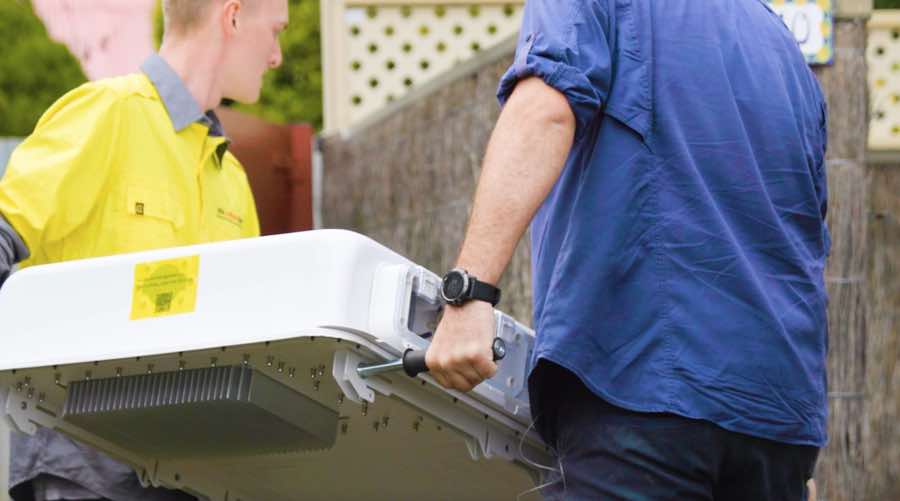
121 kg of battery goodness. And a pair of strong dudes.
The Battery Installation Was Smooth As Butter
It took the better part of a day for a two-person team to swap out my inverter and install the battery.
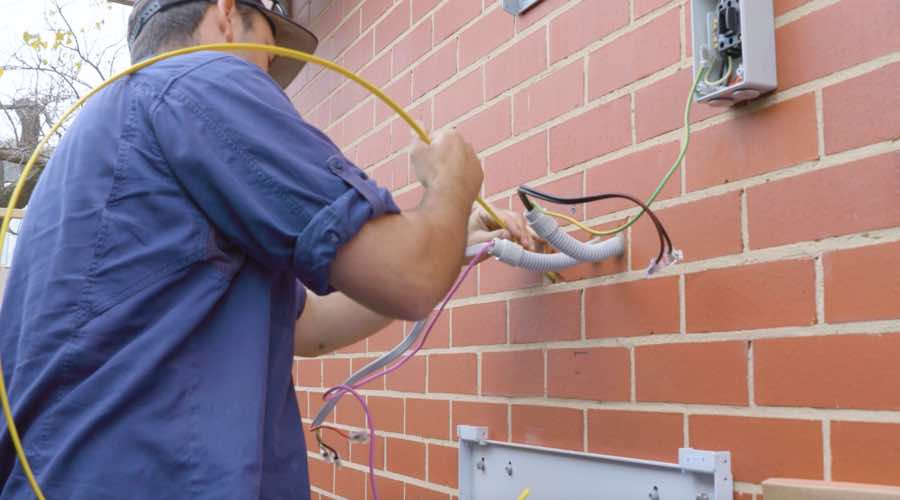
Cables in the cavity for neatness.
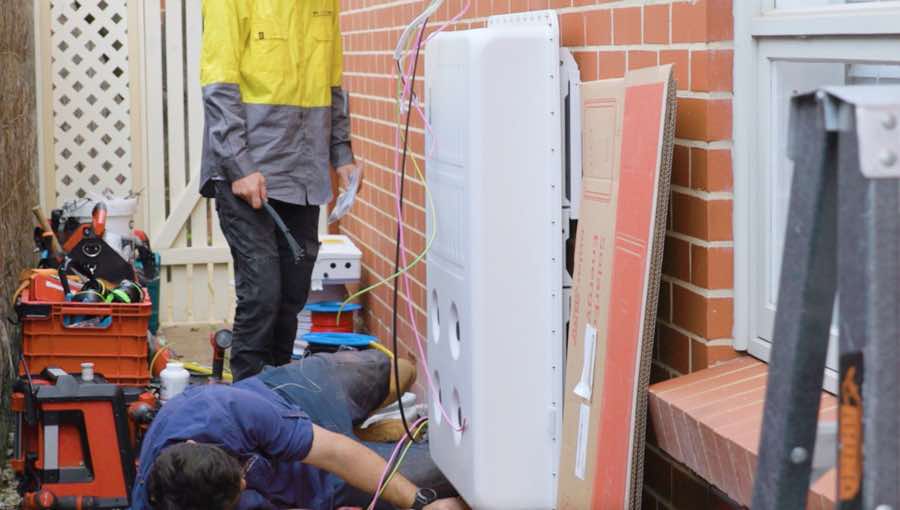
The naked battery – without its cover.
They were prompt, efficient and left me with a neat install – one whose aesthetics are worthy of a SolarEdge product brochure:
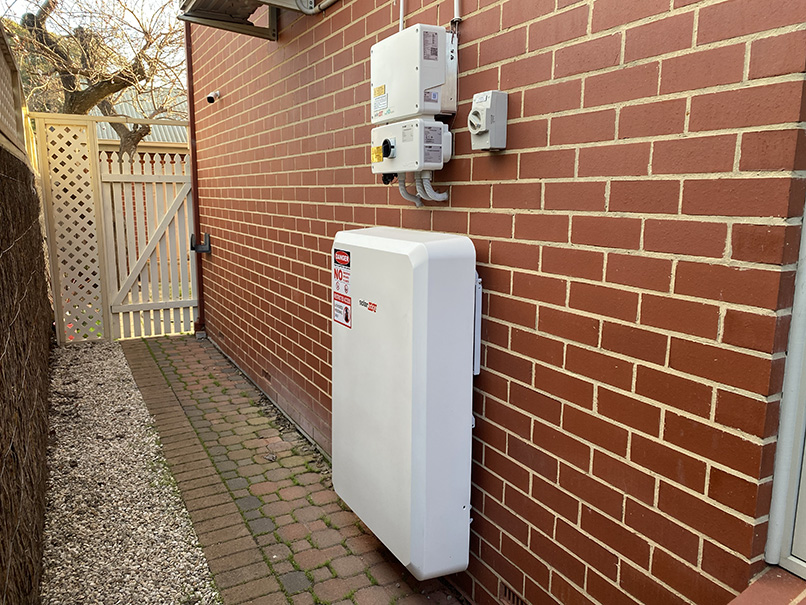
Mmm-mm.
As backup is optional with the SolarEdge Battery, and I paid for it, they also needed to install the SolarEdge Backup Box above my switchboard:
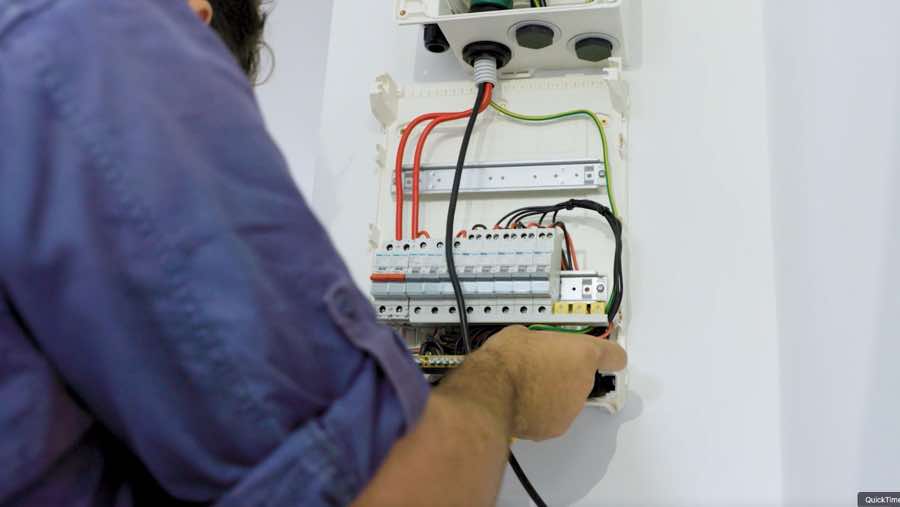
Wiring the switchboard (bottom) to the backup-box (top).
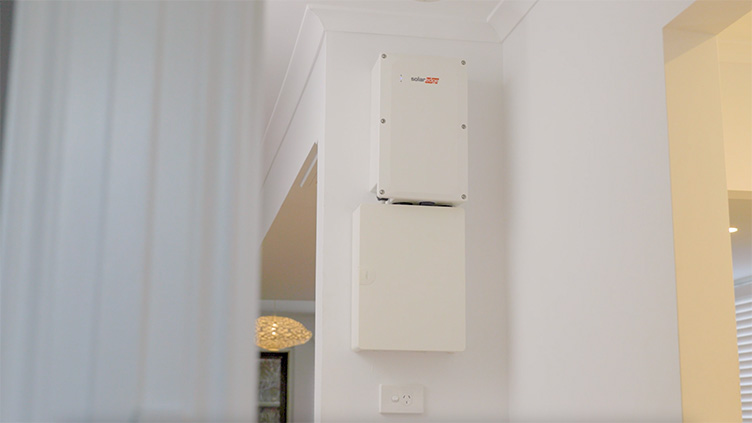
The ‘ES’ sticker was added to the switchboard after this shot!
One comment I will make about the installation – the final commissioning took ages (almost two hours). If I knew it would take ages, I would have ducked out for lunch instead of twiddling my thumbs at home.
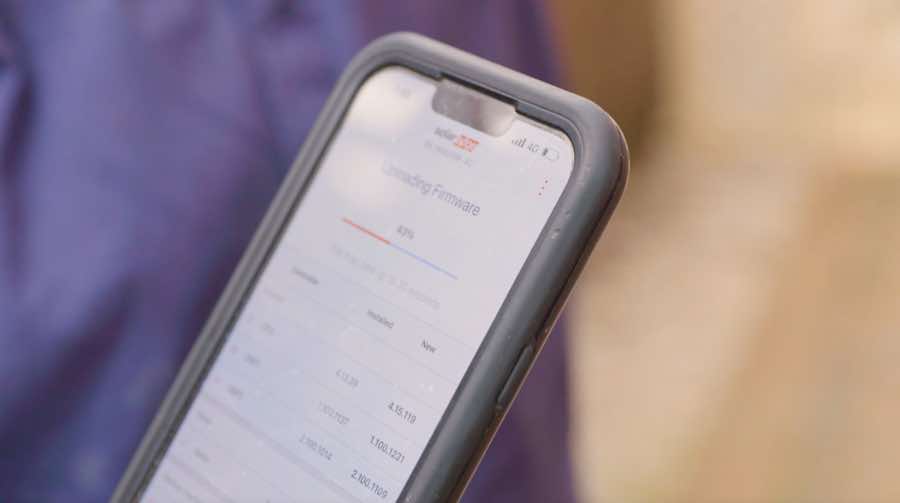
Commissioning took hours. But to be fair this was only the second SolarEdge home battery installed in South Australia.
Setting A Minimum Battery Reserve
During commissioning, I was asked, “What percentage do you want to set the minimum battery reserve?” To the non-techies, this means, “What amount of energy do you want to keep exclusively for blackout situations?”
I had to think about this one. The more I kept in reserve for blackouts, the less I’d use my battery every day – hurting my payback. But if I set it low, or even at 0%, I could be facing a situation where a blackout hit, and the battery was flat – leaving me with egg on my face.
I took a middle-ground option and had it set at 25% – keeping 2.5 kWh in reserve for use in a blackout.
After a few weeks of checking my monitoring, I realised I’d rather fully discharge the battery and stomach the embarrassment of having a flat battery if the stars aligned against me. The lost savings from having a reserve was gnawing away at me.
I couldn’t change this setting through my app – so a quick email to SolarEdge support had them do it for me.
It Wasn’t All Smiles And Sunshine
Three days after the installers packed up and left, my battery also decided to. Through diligent monitoring of the SolarEdge app, I noticed the battery was stuck on 35% state of charge:
A quick phone call to my installer got them back out the next day to try to diagnose and fix the problem. As it turns out, the battery was bricked and needed replacing. To make things worse, SolarEdge was quoting 3+ weeks for replacement under warranty.
But luckily – and this is why it’s so important to choose a good installer – SEM bought a new battery out of pocket and got it to me within the week.
It only took a few hours for them to replace the battery and get it re-commissioned. Meaning I could go back to showing off my fancy new SolarEdge Home Battery to my friends.
How Has The Battery Performed So Far?
Before buying, I confirmed with the installer my SolarEdge Home Battery would be able to provide what Finn calls “apocalypse proof” backup – which is when the battery will charge from the solar panels even if the grid is down.
It can put out 5 kW of power – which is more than my house has ever used, even with two aircons on at the same time. So I’ve rarely had to draw from the grid on top of my battery.
My typical daily usage is approximately 7 kWh in summer and 13 kWh in winter. So having a 9.7 kWh battery means I’ve almost never completely drained it, except when I’ve had a run of overcast winter days.
One quirk of the SolarEdge Home Battery’s backup is it takes a full 3 seconds to switch over in the event of a grid outage. Other batteries – like the ever-popular Telsa Powerwall – have instant switchover. SolarEdge claims this is a feature, not a bug, as it’ll be obvious when the power goes out.
As an avid PC gamer, a 3-second switchover isn’t ideal – but it’s better than none at all!
Amber Electric More Compelling Than PowerShop
Finn was keen for me to join a Virtual Power Plant – or VPP – so I’d have an extra dimension of battery ownership to write about. My enthusiasm for joining one crashed when I saw the only VPP I was eligible for was Powershop’s.
In exchange for letting them hammer my shiny new battery, they’d pay me a whopping $10 per month.
As I was preparing to make the ultimate financial sacrifice for the SolarQuotes blog by signing up for Powershop’s crappy deal, Finn invited me to a meeting with the new Partnerships Manager for Amber Electric.
We’ve written about Amber previously – but for those who haven’t heard of them, they’re an energy retailer who passes through wholesale rates for electricity.
They’re close to launching their new “SmartShift” software to the public, and they were keen to get me to join the closed beta. It allows them to charge and discharge my battery – paying wholesale rates for electricity. This can be up to $15 per kWh exported!
On one particularly good day (or bad day, if you were an Amber customer but didn’t have solar or a battery), I earned $97 in credits for discharging my battery to the grid:
I’ll Be Damned – 3 Second Blackout Switchover *Is* A Feature!
I live in a strata townhouse complex, so the main switchboard isn’t in my house – it’s in a big cabinet in the shared driveway area.
Coincidentally or not, since my SolarEdge Home Battery was installed, the mains breaker has tripped several times.
It’s obvious when this happens – because the power goes out for a full 3 seconds before the battery kicks in. So I’ve had to pay a visit to the main switchboard several times to flip the breaker back on.
A week ago, this happened at 4 am. I noticed because the white noise machine I sleep with turned off and back on, waking me up. Also, I have a one-year-old, so my sleep isn’t the best anyway.
Usually I’d be in no rush to flip the grid back on – I don’t sleep with my aircon on, so I could easily go overnight with little energy. But because I’m part of Amber Electric’s “SmartShift” closed beta – a weary check of the app showed a wholesale price spike was expected for 6 am.
My battery was only 30% charged, and at 4 am, electricity prices were cheap. So if I didn’t flip the mains back on, my battery wouldn’t be able to charge up from cheap grid energy and then earn me some serious money by discharging at 6 am.
Telling myself it’d all be worth it when I checked my savings later in the day, I jumped out of bed in my pyjamas, out into the cold, to turn the grid back on.
Current Transformer (CT) Issues
Since joining Amber, I noticed when the battery was discharging to the grid, the indicated power output was almost doubling in my monitoring app:
This could be buggy SolarEdge monitoring software, or Amber suggested the CT clamps could be set up incorrectly. I have notified my installer and am waiting on him to arrange a time to come out and inspect.
Final Thoughts
There were a few kinks along the way, some bigger than others, but with a brand new product coming from a company who hasn’t offered their own battery before – I wasn’t expecting things to go off without a hitch.
The SolarEdge Home Battery does everything I’d expect a battery to do, looks chic, and is compatible with Amber Electric’s SmartShift – significantly increasing my savings.
Would I recommend the SolarEdge Battery to a friend with a SolarEdge system? Absolutely.
Note: If you’re hungry for more technical details, Ronald goes deep into SolarEdge Home Battery specifications here.
UPDATE September 30: We’ve just released a video of the battery installation from start to finish.
Footnotes
- My employer, SolarQuotes paid for the battery and installation at market rates. SQ does not accept free hardware in return for reviews. ↩

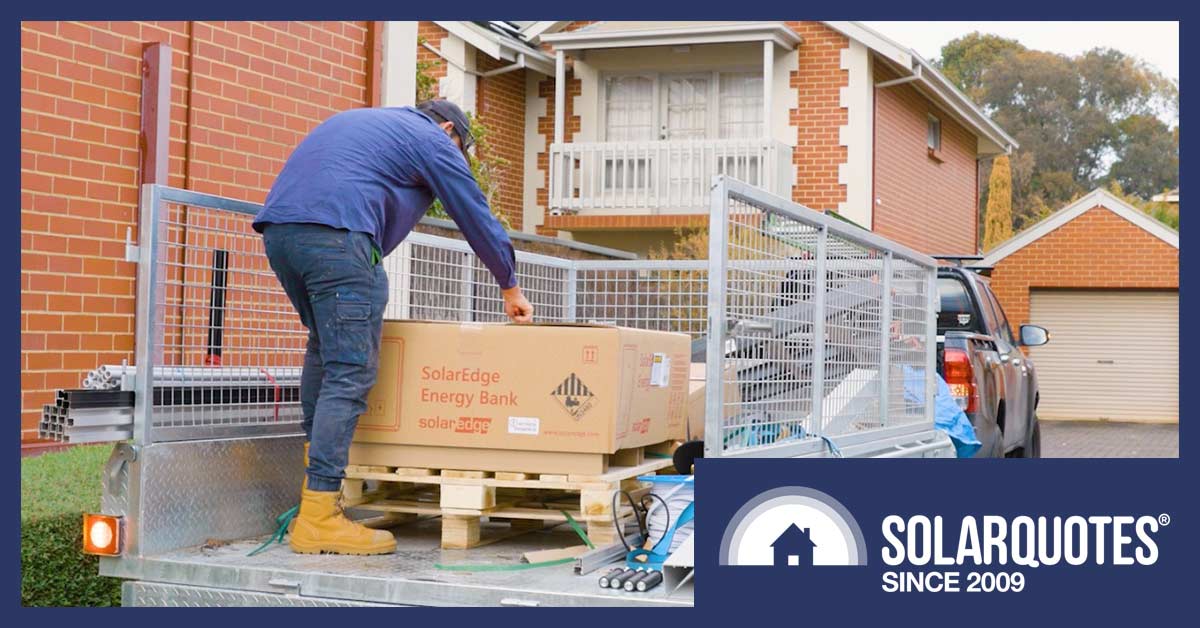
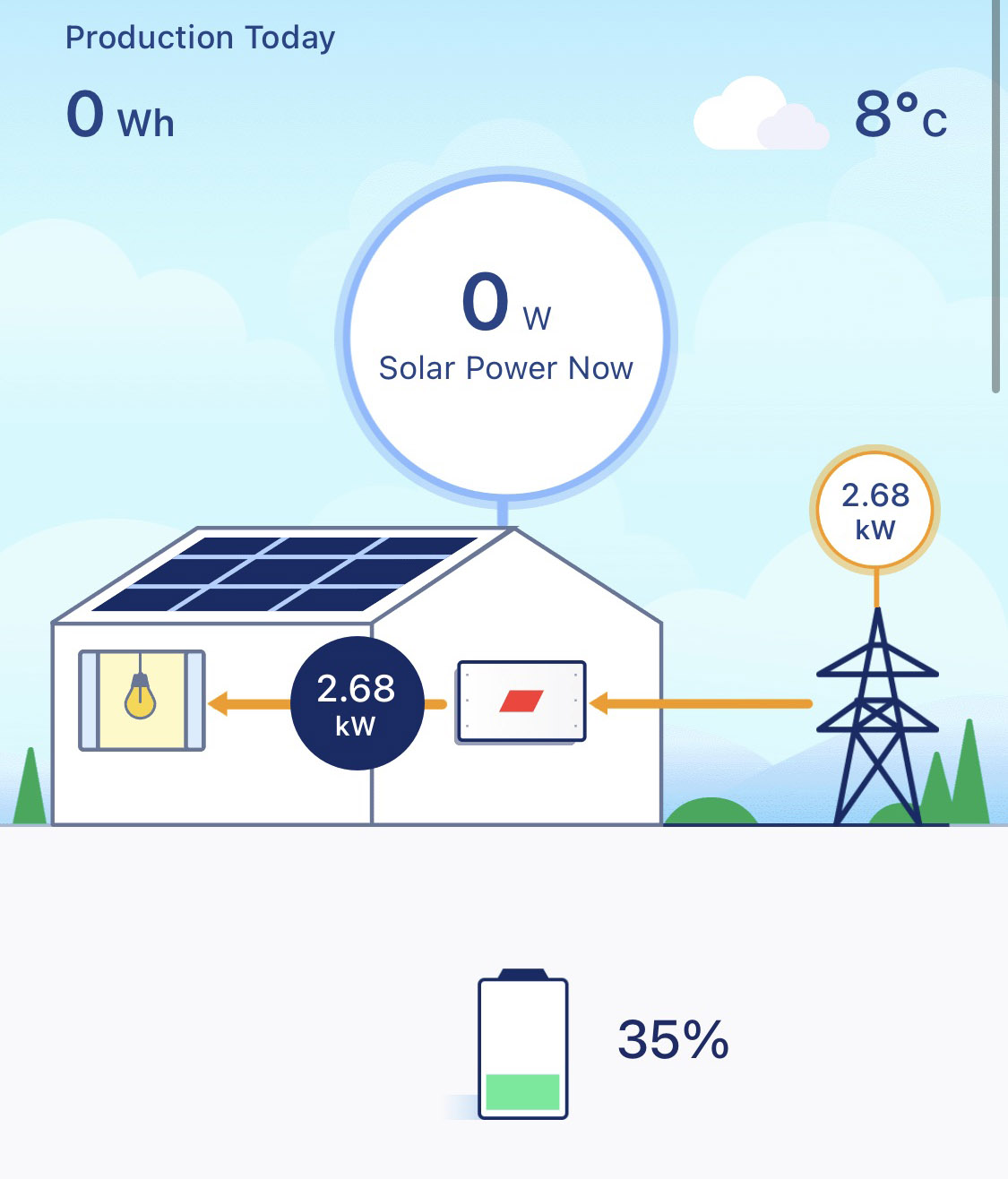
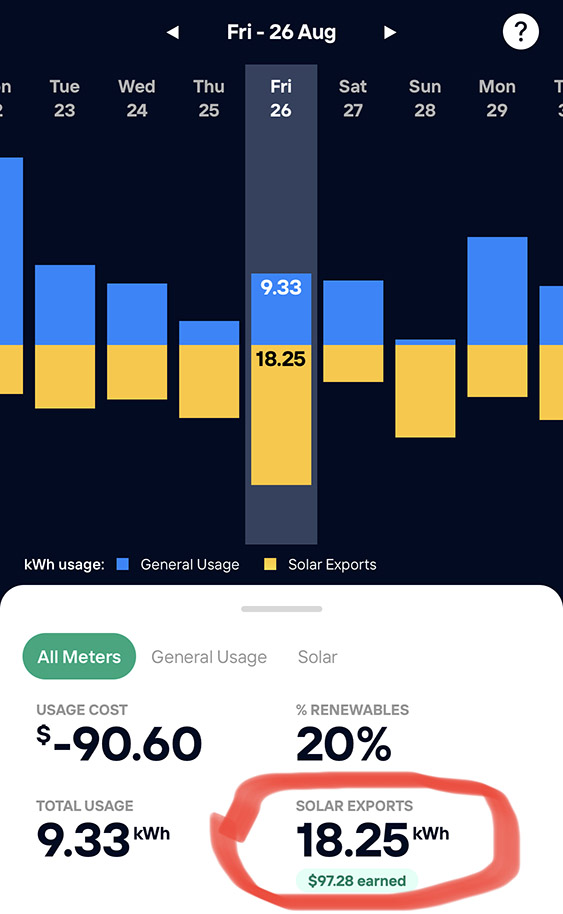
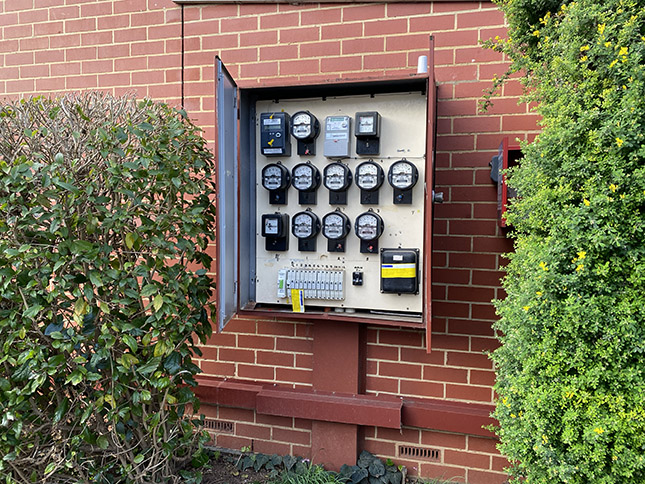
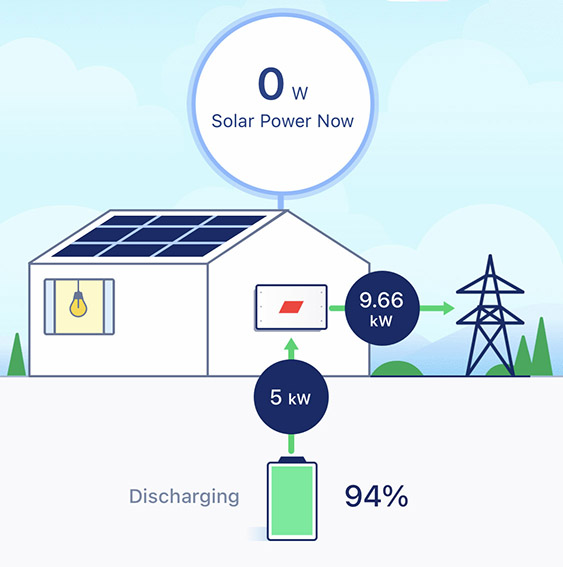
 RSS - Posts
RSS - Posts



Good info on the battery, but what is tripping the breaker?
Good question – not enough trips to blame the Battery yet – it may be a coincidence – but if it keeps happening we’ll definitely look deeper into it.
How does Amber get control of the battery?
SolarEdge API
If solaredge ever allow Amber to connect. Have been waiting 2 months now for the Amber to connect via the api.
is the trip due to earth leakage? Is the battery ground tied to earth?
Very helpful review. Thank you.
We are about to do our first SolarEdge Solar&Storage installation (here in California) and your review gave several points we will watch out for. By the way I have been following SolarQuotes for some time, keep up the great work.
Jonathan thanks for the great review. I have a SolarEdge Energy Hub so of course I’m looking at this battery vs the powerwall. Three questions. 1/ is the 3 second backup delay irritating after a while? (Tesla is microseconds). 2/ You mentioned not being able to set your minimum battery reserve easily without a call “to support”. At the moment only a dealer can change settings using the SetApp. Are SolarEdge doing anything about the lack of configuration of the battery smarts within their mySolarenergy app? As my circumstances will inevitably change (in my experience this does “living” with a solar instal, Why should I have to call a dealer each time to set this and other settings like the best time to use the battery to make the most of avoiding high peak time of day tarifs? I have heard SolarEdge “are doing something about allowing better configuration for the end user. Have you looked into this? 3/ Have you done any sums how long it will take to pay your battery off (in energy saved – not exported) vs not installing the 11K battery? Have you done any sums how much quicker this payback is signing up to Amber Electric? Thanks!
Hi John,
1) The 3-second delay is annoying for two reasons – one, it knocks out my wifi so I have to wait a couple of minutes for it to reboot. And two, it makes my appliances reset (oven, hot water panel, etc). But these are minor in the big scheme of things.
2) I haven’t heard anything from SolarEdge about their plans for future app updates/controls.
3) Yes, I plan to do a detailed blog in the future about my experiences with Amber and the impact it had on my battery savings, including comparing it with not being on Amber 🙂
1/ Get a UPS and put the wifi on that- but make sure it will work with the SolarEdge battery
2/ I have heard “rumours” many many customers are peaved with SE that the end user isn’t supported in the config of the battery( vs having to get the dealer to do it). This is a deal breaker on this battery for me (vs the easier to config Tesla). The big Q is how “dealer only” is SE and will they listen to end user feedback and change this dealer only model? I won’t hold my breath
3/ Awesome. Thanks!
Yes- best thing I ever did was buy a UPS and have the wifi running off that.
It saves an awful lot of pain whenever the grid has a hiccup.
I think my wifi would continue to run for about two hours or so from the UPS, but we’ve never had that.
David, what UPS did you choose for your wifi. Just looking for one at the moment and planning for a SolarEdge battery so seems sensible.
My battery (BYD with Fronius Gen24) also has a delay, I have a UPS on my Wifi. NBN box and router. The UPS has no delay so my Wifi never stops, worth a try.
Just get the Sonnen Evo, it’s the best!
What is the warranty on the battery and installation. Also what is the expected life of the battery down to say %70.
It’s 10 years with unlimited cycles and promises it will have at least 70% of its original capacity at the end of 10 years. Ronald goes through it in detail here: https://www.solarquotes.com.au/blog/solaredge-home-battery-review/
The thing that worries me is that SolarEdge can choose to pay you a pro-rated value of the battery in a credit that can only be used to buy SolarEdge products. For example, at 9 years it would mean 10% of current value of a new battery that I can spend on their products. Wouldn’t surprise me if it was wholesale price as well. .
They may also decide to repair or replace, but seems it is entirely up to them.
I wonder how SolarEdge trying to pay someone about $1000 for a failed battery at 9 years would fly under Aussie consumer law?.
If I am reading their warranty wrong let me know.
Tragic that Solar Edge would not supply a replacement battery in less than 3 weeks. This is my experience too on inverter warranty support.
Good to see you actually investing in the tech you report on. One thing I think is particularly good with this system is the solar panels being able to charge the backup in an outage. After that outage we had in 2016, this would be worth the extra expense to have continuous backup for extended periods rather than for the remaining charge. Otherwise it is just another brick.
Thanks for the review. I’m getting one installed in about six weeks and wondering if management of the backup reserve has been fixed so that the customer can do it via the app?
According to SolarEdge, it can be done.
https://www.youtube.com/watch?v=2eYJhUjN7Ck
Cheers
Mick
Yes – I came across that video as well in my quest to change the reserve percentage. I have asked my installer about whether I can enable that in my app (at the moment my app isn’t showing that setting).
Just got this from SE support
Hi Michael,
Thank you for contacting SolarEdge Support.
When given proper permissions, homeowners with batteries can adjust the backup reserve on their system in the mySolarEdge app. We have this feature already but installer who sets up your account needs to be aware that you want to change your backup reserve in future and they can setup accordingly.
I hope this helps.
Thank you
Customer Care @ SolarEdge
What about adjusting time of use within the mySolarEdge app? and other settings?
It looks like, for the time being at least, that consumers are locked out of these settings on the app.
I recently had a solaredge system installed including battery. My installers enabled access for me to change the reserve setting and it also allows setting a duration.
Eg there is a planned outage you can reserve battery use for that.
The solaredge software that decides where energy should be directed, does make some strange decisions. Not sure if there are any comparisons for various systems but it would be good information to share.
Is the home all electric? Size, number of occupants?
Any anticipated future changes to electrical energy consumption, such as an EV?
These commercially installed batteries are still well over $1000/kWh, which is just too much.
House is roughly 140sqm. 3 occupants.
Gas for cooking/water (I’d be all electric if I had the cash!)
EV will be added within next 2-5 years.
Jonathon Wedge,
“Gas for cooking/water (I’d be all electric if I had the cash!)”
A one-off capital expenditure can save substantial recurring energy costs, particularly for high energy use appliances like hot water services, in the longer-term. See Tim Forcey’s chart titled Melbourne house – Net imports of electricity & gas at: https://thefifthestate.com.au/columns/spinifex/home-electrification-in-one-chart/
Gas is NO LONGER CHEAP.
https://www.aer.gov.au/wholesale-markets/wholesale-statistics/gas-market-prices
Australia’s domestic gas supply is finite and South Eastern gas fields are already in decline.
https://twitter.com/crudeoilpeak/status/1529098069891239936
Evidence/data indicates it’s time for Victoria to transition away from fossil gas dependency, fast.
https://www.solarquotes.com.au/blog/dalvui-battery-corangamite-mb2570/#comment-1483979
I’d suggest declining gas production in Victoria will likely have an influence on reducing the availability of gas supplies and increase retail prices also in NSW and South Australia.
The fact that you have to ring up your installer to control basic functions of a battery that you paid $11,000 and own just seems crazy to me. Owners of a Powerwall 2 through the app can remotely change the battery reserve amount at their whim with a slide control. They can remotely get the battery to charge up from the grid when they know a big storm front is going to roll through in a while, and also tell it to go off-grid while the storm is happening. I don’t understand why other battery manufacturers force the owners of their batteries to have to ring up the installer to be able to do this. Are they afraid the owners of their batteries are going to brick the battery by doing so? Imagine, you wake up after midnight and check the weather report to find out a storm is going to hit in a few hours. What are you supposed to do? Ring up the installer and say, “Sorry about this. I know it’s 1 am but can you set the battery to charge up from the grid now please?”
It will all be about who has “control” of the end user ie who is “the customer”. If SE thinks the dealer is “the customer” nothing will change here. This issue was fought out early on in the home automation industry with dealer focused (rather than end user focused) companies like Control4 and Crestron eventually going out of business vs the end user focused Google home and Alexa. I have my doubts. Looks like the same issues here as early on in the HA industry..
Can this Solar Edge Battery be charged with an enphase micro inverter system ?
It is designed to be specifically DC coupled to the SolarEdge Energy Hub inverter, to the best of my knowledge.
Disappointing from a high tech company like SolarEdge that a battery can be bricked within 72 hours. Sounds like a cool experiment, although you’re a very low power user.
Looking forward to the next installment.
BTW – the tripping breaker could be from the current inrush when the charger is first turned on or it could just be a faulty breaker – seen plenty of them before.
All this information is well & good if you are tech savvy but what if your not. You rely on the person or company doing the install to set it up correctly in the first place & if they don’t you’ll be none the wiser. As for diagnosing any faults, well good luck with that, sounds like you’re caught by the short & curly’s beholding to them. Looks like solar not that good if you’re not technically inclined.
Me as well regarding the lack of tech savvy. It seems I need to spend more time on this excellent site to learn more. Have installed (NRG) a 13.125kw system 18 months ago and now am considering a battery. It took me 2 years to decipher all the sales ‘options’. Hopefully I’ll grasp the tech language and make a decision a little quicker if and when we decide to proceed now the hardware is in place.
We have had a solar edge system (in Perth) or almost 4 years with no issues. Our installer has recently shut down. As luck would have it our system is now not working. The responses from solar edge have been slow to date- I’m hoping it improves but it am concerned about how reliable the support process is – to the point of whether I should risk further investment in one of their batteries. Disappointing really.
Excellent review guys & thank you to Jonathon
I have a 10kw system with LG panels with optimisers and the SE hybrid inverter installed in December 2021 – all working well with no issues.
Have been researching SE Battery since but hard to justify the outlay and was concerned about teething problems
One item I can’t see in your photos is a ‘DC combiner’ which was in my quote for one battery of $11999 (Feb 22)
Did the installers just double terminate over the solar panel outputs or are there other options that don’t require the combiner?
If a second battery was considered later, how is that accommodated?
Hi my name is max burrows and i am in nsw ihave a 6.6 system with 13kw battery installed 4 years ago it worked extremly well untill lightning struck our house and wiped out twenty thousand dollars worth of electronic equipment including solar. Thanks to good insurance all was replaced and working well. I have not had an electricity bill since instalation and in fact have received a 400 dollar cheque. I am considering either increasing panel numbers or doubling battery capacity.the pore feed in tarrifs being offered encourage a move to zero use i am curently saving about $3000 per year on past bills
Excellent review thanks. I have a 10kwh battery (not SolarEdge) and very happy.
I signed up for Amber Electric but for my circumstances, it did not work well. Maybe the version you are on works better. I discovered the algorithm was charging my battery for a higher price than the discharge, so effectively I was subsidising the grid. It may have ironed out the wrinkles after a further couple of weeks, and Amber suggests that the algorithm needs a fair bit of time to calculate usage patterns and the like. And I got nowhere near the price you were getting (max was about 80 cents kWh.) So I bailed. I will be interested to hear how you go in the long term.
William – you can set your ‘profile’ in Amber’s SmartShift to be super conservative and only discharge at times of super high electricity prices – see screenshot: https://www.solarquotes.com.au/wp-content/uploads/2022/09/smartshift-1.jpeg
If yours was acting funny outside of the parameters you set, might be a bug in the software.
Yes, thanks for that. In the version of Amber I was on there was no capacity to change any settings. Everything was determined by the algorithm. This new “smart” version seems a big leap forward, and I will look closely at that.
Hi Jonathon
Have also just had a 6kW energy hub inverter and backup unit installed along with a 5kw inverter on the second phase.
The “double” grid output value in my system was due to the back up unit and the monitoring unit both having C.T.s and thus displaying double the output.
I have removed the C.T. from the monitoring unit (as the backup unit CT is integrated and the monitoring ones were clip-on around the phase wires).
Maybe a follow up with your installers cold verify this.
And apart from having the C.T. wiring crossed over (which caused the battery to discharge as soon as the sun came up and then recharge from the grid), it is generally working very well.
The 9.7 kwhs (even with a backup of 25%) can often get me through the night if there’s been enough sunlight to recharge to 100% (and I only expect this to get better into summer)
I have a SolarEdge battery as well – same model as you.
The problem I’m facing is SolarEdge dont seem to allow the features that my friends Telsa battery get; namely the ability to micro control how the battery works.
For example, I want to have my battery charge using the grid during the offpeak power night when the battery is at 0%, so that I can have battery power ready in the morning to offset the shoulder charge (and as backup for power outages). This gives a significantly better ROI – because you dont need to have your 25% buffer – you can let it run to 0% during ‘peak’, and charge back up to 30% or something during offpeak.
My supplier and SolarEdge keep going back and forth on it.
Also – I wouldnt call the “3 second outage” a feature. If it was something that was configurable, that is a “feature”. When its a physical limitation of the system, then just call it what it is; a limitation that solaredge is pretending is something else.
This guy in the UK seems to be doing what you are talking about
https://youtu.be/FAvIb4Oti5k?t=626
He self-installed the battery and looks like he had quite a bit of back and forth with SE before he was able to access some of the functions.
I hope this changes as time goes on. I am going to be pretty unhappy if I have to contact my installer to change basic stuff like reserve level.
Oh sick – thanks for that video. I have a good relationship with my installer, so I’ll watch the videos and explore this some more.
I wonder if the installers can also give you access to this stuff? Mine is getting installed Nov 10th if all goes well and I would love to have access to the profiles and set up things like the guy in the video.
I love tinkering with settings and may tell my installer if they don’t give me access, I’m going to be calling/emailing them constantly to try different charge / discharge profiles and reserve settings almost daily. Maybe this will frighten them into giving me access..
I am looking to get a battery in about 12 months (when I get some money from Super) and use it for my house and an electric car I also plan to buy. I live in the Bass Coast outside Melbourne and we get about 8 power outages a year, 4 planned and 4 unplanned. I currently use a petrol generator when the power goes off and run it for an hour or so then go for a drive. If it is a planned outage, which can take from 4-8 hours, we are notified in advance by text and letter. It would be good if the batteries had a way of letting it know that you wanted maximums storage possible at 9am of X date. It sounds like you would need to email them to change it, then change it back. Unplanned outages are trickier as often happen in storms at 3am. Maybe like now I will just go back to sleep and run the generator in the morning. Also I am in a wheelchair and unable to get to the power board so flipping the switch is not a minor inconvenience.
Sounds like there are a couple of “features” they need to sort out before I will buy this brand of home battery.
Very cool I didn’t know solaredge had a home battery i have there auto transformer and really like it
: https://youtu.be/5GYtae_EQkY
A few weeks ago we upgraded our solar system to include the Solar Edge battery with back up. We have had a 5kw Solar Edge SE5000h inverter for almost 3 years. I have read mixed reviews about the Solar Edge battery. I approached my original solar installer in June 2022 to ask about batteries . They said they were doing the Solar Edge Battery training course and would let me know if it was worth considering. 2 months later they seemed unable to recommend it. So I went back to Solar Quotes to check Battery options with another installer.
Of the 2 quotes received. One installer couldn’t recommend the Solar Edge Battery but the other one did. Their proposal included additional solar panels, along with a free upgrade to the SE 8.25kw Hybrid Inverter. The plan seemed great…. But then there was the wait for components to arrive. I almost cancelled the week before Christmas as I had organised a Tesla Powerwall install instead. But I was offered an installation date on the 4th of January… so we went for it.
The installation went without a hitch. Neat job. Took all day so they returned another day to commission the system….. it worked straight away without a hitch. Solar Edge App updated with all the new icons. Impressive see all the inputs and outputs in just one app.
We have been pretty well living ‘off-grid’ since then … except for exports . It’s a game changer!.
We were already with Amber Electric . So enrolled the battery for SmartShift . I set my backup level at 5%. But from what have seen this can be overridden via SmartShift. Now have ability to charge from the grid or sell to grid up to 5kw rate any time.
We are now no longer interested in buying power , it’s all about selling. Hoping to get one of those spike events Jonathan described…
So overall a positive result. The most frustrating part was waiting so long due to supply chain issues . But probably blame COVID for that!
Hi Alex,
If you don’t mind, how much did you pay for the battery? I am really interested to have SolarEdge battery installed.
I’ve got SolarEdge Genesis inverter already, just the battery needed. I need to do some calculations based on the actual battery’s cost and installation cost.
Thanks,
I paid $17k incl GST. That included upgraded inverter, another 4 kw solar array with optimisers (to integrate with my existing 5.5kw array) along with battery and back up installed.
Not sure what the separate cost of the battery was.
We have been recently quoted for a Jinko panel/SE Genesis inverter + 10kW battery system – with and without the battery. So the battery alone looks to come in at around $16K, before government rebates.
Hope that helps! Am in outer eastern Melbourne
Thanks David and Alex.
I look for just a battery itself + installation cost as I have the latest SolarEdge inverter.
I probably will bite a bullet and get it done soon :).
Thanks for the review, good feedback
Hi All,
I had my SE battery installed in Feb2023 after a long wait due to supply issues too, over 3 months in the end.
I already had a SE 6.6 system with 5kw inverter so I got the free inverter upgrade and I chose to go to a 6kw
Inverter to get full use of my panels as i have no more room on my roof. I paid just 13k inc battery backup.
I have 2 major issues and im wondering if anyone else suffers the same as me as to date SE have not accepted there’s a problem and my installer is as frustrated as me.
1) all the readings on the SE app are exaggerated some times it even says I get a constant 7kw of solar production in March which is not possible. Imports and exports are also overstated to my meter readings too.
2) it does not like air fryers and inverter cooktops at all, the battery seems to not be able to respond fast enough and over compensates then cuts back and the cycle goes on and on the result being that i import min 500w to 1kw of power every day from the grid mainly as a result of cooking activities. SE say an import of 100w is normal and i would accept that as being ok.
I’m very lucky in that i use Home Assistant via modbus tcp access to the battery so have total control of the settings and can do anything i want when ever i want via automation or manual switching. So for me, this was a real plus in going for SE as it supports this integration with Home Assistant.
Would love to hear other owners’ experiences.
Jay
Hi Jay
Looking at Modbus, it seems like you need to be very tech-savvy to set up and use it… True?
What extra features/controls over the standard SE app does it enable?
We’re in the process of getting a SE battery installed as part of a new system, but I don’t really want to be having to fiddle with an app multiple times a day to keep the whole shebang running smoothly. Your thoughts greatly appreciated!
If you use Home Assistant and the Solaredge integration, you have opened up a whole new world of possibilities and control.
I’ve set it up (it wasn’t that hard and there is plenty of help) and it does the following
– look at the battery state of charge
– look at the solar forecast for my location
– turn on devices based on their consumption so that at the end of the day the battery is charged (any amount you choose) and you have maximised your self consumption.
Others have gone further to automate when to sell and buy power.
Of course you don’t need to change anything, you can just have more information if you like.
Yep Home Assistant is what i use and it lets me do things like charge the battery overnight if there is little Solar the next day.
I can pretty much do anything manually, stop discharge, start charge and how much. But automation with HA is where it shines.
Was pretty easy and as noted there is a lot of help available from the home assistant community.
One you set it up its set and forget. Took a bit of trial snd error but now its working perfectly and i dont touch anything.
I will say one thing, it does work over wifi but as your router is inside and inverter outside the modbus can drop out, i recommend an ethernet connection to the inverter for reliable connection.
I also fixed all my issues, the installer had used both the internal CT and the CT from my old modbus meter and they were fighting each other hence my issues, once the external one was removed all fixed. Make sure your installer has done a few installs and has a good relationship with SE it helps a lot to get it all working perfectly.
Jay
Exact same thing happened to me, except it took me three months to get a replacement battery. (installation happens in 3 days).
What battery profile are you using? I’m finding their profiles do not explain the battery behavior in enough detail to know in advance how it is going to perform.
I’m thinking of using maximize self consumption when I want to charge the battery (I’m expecting excess solar at this point).
Then when the high price time of day kicks in, I’ll switch to discharge to minimize import.
Suggestions are appreciated.
I find that “charge from PV only” gives me most control. It will consume all of your PV up to 5 kW, so I wait until 11 am before I enable “charge from PV” so that I’m producing more than 5 kW and my daily usage won’t pull from the grid. Then I tell it to minimize import during the high tariff times. Usually, the battery gets down to 55%, and it takes about 1 hr to recharge when 5 kW of solar is feeding it.
I use max self consumption all the time, the only time i change it is if there is less that 10kwh predicted solar for the next day i charge the battery to 50% if its below that or stop the battery when it gets to 50% and use off peak rates after 10pm to do that, then back to max self consumption at 7am when the rates go up again.
Thats it i only every pay off peak rates and only during winter when solar production is low as i only have 6.6 kw system.
Jay
I have a solar edge system. No battery. Does this work well with 3 phase?
Hi Ron,
It depends, if you want 3 phase backup for a 3 phase load, Solar Edge can’t help. More details here; and even more to come in a new post soon.
Actually it can work, at least that’s my understanding here in Sweden. We have just installed and turned on a 3-phase 10kw SE system with Home Hub and one 4.6 kw battery. The Backup Box will be installed along with two more batteries later but it is understood that it will be a 3-phase backup to the whole house. We had to draw a second 3-phase cable from the inverter/battery to the house for this. However I will stop the 3-phase equipment from running in the case of a grid-down emergency and make due with single phase back-up equipment for them. 3-phase homes are the norm here in Sweden so different simple things are on different phases.
Jonathon, thanks for sharing your observations.
This is my experience.
I have 9.24 kW of solar panels on a second story north facing pitched tiled roof together with a Solar Edge Inverter, battery back up module & 10kWh 400V battery.
With the shrinking FIT in Victoria I thought I would give Amber a shot. It took a week or so for the battery / inverter to be registered and from that day it has all been down hill and bad experiences with Amber.
Smart Shift automated AI algorithm is stated to take 1 month to learn however my experience is that it must not have any intelligence to start with.
With significant solar being available, a full battery, Smart Shift will be importing power from the Grid.
With battery curtailment switched off & battery at 50%, it will export power into the grid at negative FIT rather than fill the battery.
Even when going into self consume mode, I am on average importing at least 30% of power from the grid.
The Amber Smart Shift APP regularly states a communication error and that the “plan” function won’t work.
The problem is that the blue communications status LED on the Inverter states the inverter is communicating & this is confirmed by using the Solar Edge APP and also looking at the connection status via the router interface.
Thus, the APP is extremely buggy to the extent that I loose control of my system. This could be a costly exercise in price spikes.
Amber “support” is a complete misnomer.
Over the last few weeks of August, there has been little opportunity to export power in times of high FIT prices & this is most likely to only get worse with more renewables coming on line.
In closing, very happy with my Solar Edge system that has been installed for 10.5 months (10.6mWh generated) & up until switching to Amber, I have been cost neutral.
Definitely NOT happy with Amber & have began the process to switch electricity suppliers.
Tony, REC 7359
Hi,
did you ever try a blackstart/coldstart if there was (simulated) no grid power and the battery went totally empty dring night?
Trying this usecase currently with my SE10KRWB Home hub and the low voltage 48V Batteries – and this doesn’t work due to communication issues between battery and Inverter when the inverter boots in the morning without a grid connection.